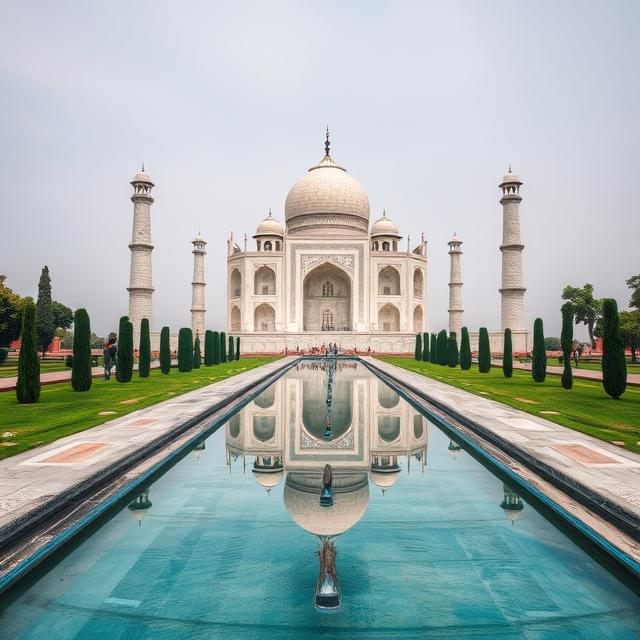The Taj Mahal, one of the most iconic landmarks in the world, is a breathtaking testament to love, artistry, and architectural brilliance. Located in Agra, India, this white marble mausoleum was commissioned by Mughal Emperor Shah Jahan in memory of his beloved wife, Mumtaz Mahal, who passed away during childbirth in 1631. The Taj Mahal’s stunning beauty, intricate craftsmanship, and rich history make it a must-see destination for travelers from all over the world. As a UNESCO World Heritage site, it draws millions of visitors annually, who come to marvel at its splendor and to learn about the profound love story behind it.
Approaching the Taj Mahal, visitors are greeted by its magnificent symmetry, set against a backdrop of lush green gardens and reflective pools. The mausoleum is centered on a large, elevated platform and is surrounded by expansive courtyards and fountains. The building itself is a masterpiece of Mughal architecture, blending elements of Persian, Ottoman, and Indian styles. The gleaming white marble, adorned with intricate carvings and semi-precious stones, glows in different hues depending on the time of day, making it a truly magical sight at sunrise and sunset. Visitors often find themselves mesmerized by the play of light and shadow across the delicate patterns of the marble.
Stepping inside the Taj Mahal reveals an ethereal beauty. The central chamber, where the tombs of Shah Jahan and Mumtaz Mahal are housed, is serene and peaceful, with soft natural light streaming through the high marble dome. The marble latticework, along with intricate floral designs inlaid with precious stones, showcases the exceptional skill of the craftsmen who worked on the monument. The symmetrical layout of the Taj Mahal, both in its architecture and gardens, reflects the harmony and balance that was central to Mughal design and aesthetics.
The Taj Mahal’s gardens, known as the Charbagh, are a delightful place to explore. Designed in the Persian style, the gardens are divided into four quadrants, each representing a paradise on earth. The pathways lined with water channels and fountains lead visitors through lush greenery, offering beautiful views of the monument from different angles. The entire setting evokes a sense of tranquility and peace, providing a perfect backdrop for reflection and admiration. The gardens are especially beautiful during the early morning hours when the site is less crowded, and the cool air adds to the serene atmosphere.
One of the most captivating aspects of the Taj Mahal is its timeless love story. Shah Jahan’s devotion to his wife is etched in every marble stone, making the Taj Mahal not just an architectural wonder, but also a powerful symbol of eternal love. It’s said that after Mumtaz Mahal’s death, Shah Jahan was so grief-stricken that he decided to build the Taj Mahal as a monument that would reflect his deep sorrow and love for her. The sheer scale and grandeur of the structure stand as a lasting reminder of this profound bond. Visitors often find themselves moved by the story, as well as the beauty of the monument itself.
When visiting the Taj Mahal, it’s important to take time to absorb the history and significance of this remarkable site. While the monument’s architectural beauty is the main draw, the surrounding areas of Agra also offer rich cultural experiences, such as the Agra Fort and the bustling markets of the city. To make the most of your visit, it’s recommended to arrive early in the morning to avoid crowds and catch the monument bathed in the soft, golden light of dawn. Whether you’re a history lover, an architecture enthusiast, or simply someone seeking to witness one of the world’s greatest wonders, the Taj Mahal promises an unforgettable experience that will stay with you long after your visit.

Leave a Reply